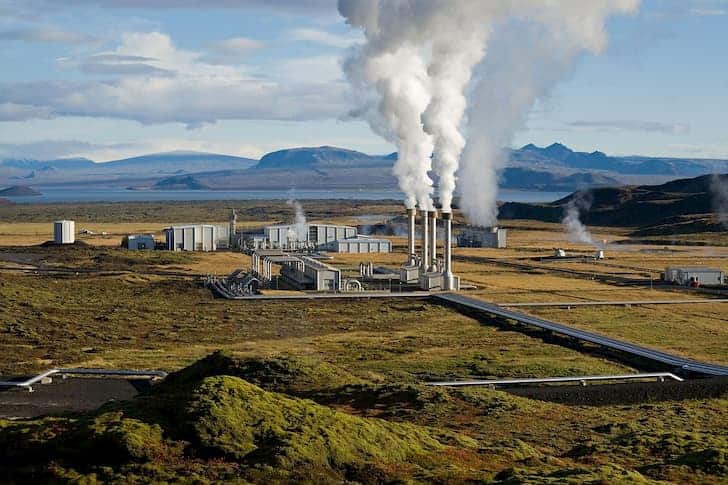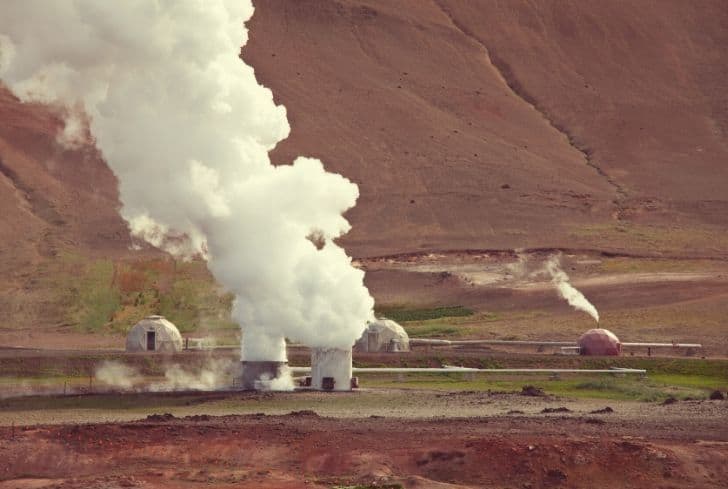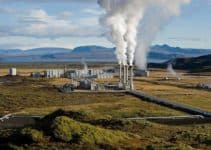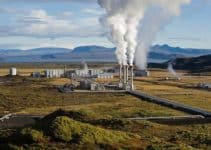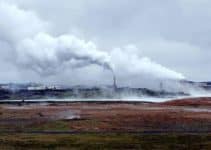There are a lot of sources of energy today, with some being renewable and others not. An excellent source of non-renewable energy is the burning of fossil fuels such as oil and natural gas, while some of the renewable sources of energy include solar, wind, hydroelectric and geothermal energy.
Geothermal energy is derived from the heat that comes from the sub-surface of the earth. It is contained int eh rocks and fluids beneath the earth’s crust and can be found as far down to the earth’s hot molten rock, magma. This article will talk about geothermal energy, its past, present and future.
Geothermal energy has been in existence for billions of years. However, history says that geothermal energy has been in use for about 10,000 years, starting with the Paleo-Indians who used the hot springs and natural pools for cooking, bathing and warmth. According to Britannica, the world’s first district heating system was installed at Chaudes-Aigues, France in the 14th century, but it was not until the late 19th century that other cities and industries realized the economic potential of geothermal resources.
The first industrial use of geothermal energy began near Pisa, Italy in the late 18th century. Steam coming from natural vents (and from drilled holes) was used to extract boric acid from the hot pools that are now known as the Larderello fields.
The first residences to receive geothermal heat were in Warm Springs Avenue in Boise, Idaho in 1892 and the first geothermal electric power generation took place in Larderello Italy in 1904 by Italian scientist Piero Ginori Conti.
It also offers that the American and Italian plants were dry steam facilities, where low-permeability reservoirs produced only steam. However, New Zealand was able to produce 80% superheated water and 20% steam due to their high-temperature and high-pressure water, which emerges naturally.
The geothermal power plants in New Zealand were commissioned in 1958 and the Geysers in northern California were commissioned in 1960. The steam from the ground generates power right away and is sent to the power plants through pipes. In contrast, the superheated water from the ground is separated from the mixture and flashed into steam. Most geothermal plants at present are of this latter “wet steam” type.
Development of Geothermal Power Technologies
1. Dry Steam Geothermal Plants
These are the original geothermal power plant systems. They used and use the steam provided by a hydrothermal reservoir directly to spin generator turbines
2. Flash Steam Power Plants
These are the most common geothermal power plant types in the world and are more energy-efficient than dry steam plants. The technology used relies on highly-pressurized reservoirs where the water exceeds 360°F (182°C).
The pressure pushes the superheated water to the surface, where it enters a tank at a much lower pressure than that which exists underground. Once in the tank, the lower pressure causes some of the water to be “flashed,” or vaporized, generating steam that turns a turbine. The excess water, that is not flashed, is injected back into the hydrothermal reservoir for later use
3. Binary Cycle Power Plants
This is the newest technology in geothermal energy generation and accounts for the vast majority of geothermal growth in the US and around the world over the last few decades. Hydrothermal reservoir water is needed to heat another working fluid with a much lower boiling point. The hot water is reinjected back into the reservoir with the heated working fluid becoming vaporized, thereby generating steam that spins a generator turbine.
Geofluid, or the fluid drawn from underground, may contain dissolved carbon dioxide. While other systems use geofluid directly and allow the carbon dioxide to escape from the fluid, binary cycle systems do not, since the geofluid and the working fluid never come into direct contact, the carbon dioxide in the geofluid is not released and instead is re-sequestered underground. Therefore, binary cycle systems result in little, on a life-cycle basis, to no greenhouse gas, on an operating basis, and particulate matter emissions.
4. Enhanced Geothermal Systems (EGS)
EGS’ make use of geothermal resources sourced from much deeper reservoirs than the systems already discussed. These resources are typically not economical to developers for a variety of reasons, the most common of which being that the deep reservoirs are often not permeable enough for hot water or steam to flow up to the surface.
To overcome this, enhanced geothermal systems inject fluids into the ground at high speeds to fracture the deep rock, permitting flowing channels to form and water to reach more accessible depths and deposits. Enhanced geothermal systems are typically configured as binary steam plant models and are especially useful for hot, dry rock situations.
The Emergence of Geothermal Energy Over the Years
1. 1807: A European settler, John Colter, while visiting the Yellowstone area, encountered hot springs, leading to the designation “Colter’s Hell”. Hot Springs, Arkansas was also founded in 1807.
2. 1830: Asa Thompson charged one dollar each for the use of three spring-fed baths in a wooden tub, making this the first known commercial use of geothermal energy
3. 1847: William Bell Elliot, stumbles upon a steaming valley, just north of what is now San Francisco, California. He called the area ‘The Geysers’, which is a misnomer, and thought he found the gates of Hell. The Geysers was developed into a spa, The Geysers Resort Hotel in 1852, hosting, among others, future presidents Ulysses S. Grant and Theodore Roosevelt.
4. 1892: The world’s first district heating system was introduced in Boise, Idaho, with water being piped from hot springs to town buildings. Today, there are four district heating systems in Boise, providing heat to over 5 million square feet of residential, business and government space. At the same time, there are 17 districts in the US and dozens more around the world using the same system
5. 1904: The first geothermal power plant was invented by Prince Piero Ginori Conti at the Larderello dry steam field in Tuscany Italy.
6. 1948: Professor Carl Nielsen of Ohio State University developed the first ground-source heat pump, for use at his residence, while J.D. Krocker, an engineer in Portland, Oregon, pioneered the first commercial building use of a groundwater heat pump
7. 1970: The Geothermal Resources Council was formed, to encourage the development of geothermal resources all over the world. The Geothermal Steam Act was also enacted in the US, providing the Secretary of the Interior with the authority to lease public lands and other federal lands for geothermal exploration
8. 1972: The Geothermal Energy Association (GEA) was established. The body develops geothermal resources around the world for electricity generation and direct-heat uses
9. 1977: The US Department of Energy was formed
10. 1984: A 20MW plant began generating power at Utah’s Roosevelt Hot Springs. In Nevada, a 1.3MW binary power plant began operations and a 50MW power plant goes online in Imperial Valley, California. Electrical generation began in Hawaii with a 25MW geothermal plant in 1992, and a 23MW binary power in Steamboat Springs Nevada in 1993
11. 1994: The Department of Energy created two industry/government collaborative efforts to promote the use of geothermal energy, and reduce greenhouse gas emissions. One effort was directed toward the accelerated development of geothermal resources for electric power generation and the other was aimed towards the accelerated use of geothermal heat pumps.
12. The 2000s: More laws were enacted. The Energy Policy Act was enacted in 2005, providing tax incentives and loan guarantees for different types of energy production. In the same year, 14,800 GWh of electricity was generated, enough to serve the annual needs of about 1.3 million homes. In 2007, the Energy Independence and Security Act of 2007, was introduced, providing authorization and direction for activities related to the Department of Energy’s geothermal research
13. 2009: In 38 US states and the District of Colombia, the Geothermal Technologies Office gave out awards of $368.2 million to 149 geothermal projects
14. 2011/2012: The geothermal industry in the US grew steadily in 2011 and the first quarter of 2012, with geothermal companies increasing their capacity from 3102MW to 3187MW
15. 2013: The Department of Energy invested in a project that allowed it to take advantage of closed-loop geothermal electricity generators, generating zero-emission electricity for less than 6cents/kWh.
16. 2015: More than 80 countries were using geothermal energy, led by China, Turkey, Iceland, Japan, Hungary and of course the United States. According to Britannica, the total worldwide installed capacity for direct use stood at about 73,290 megawatts thermal (MWt), utilizing about 163,273 gigawatt-hours per year (587,786 terajoules per year)
17. 2016: The total worldwide installed capacity for electrical power generation stood at about 13,400 MW, producing approximately 75,000 gigawatt-hours per year for a utilization factor of 71%, which is equivalent to 6,220 full-load operating hours annually.
18. 2019: Seven US states had geothermal facilities, ultimately generating baseload power accounting for 4% of all US utility-scale generation or 16 billion kilowatt-hours.
Future of Geothermal Energy
1. Drilling wells
Over the years, we have become better at generating geothermal energy. For the future, we will only get better at drilling geothermal wells with increasing efficiency, allowing more energy to be captured in each plant.
2. Improved ‘binary cycle’ plants
Traditionally, ‘dry steam’ geothermal plants used to emit greenhouse gases, even if it was about an eight of that of coal plants. However, they were emissions, nonetheless. Today and into the future, engineers have devised and will continue to improve on ‘binary cycle’ plants, that release no emissions into the atmosphere, except water vapor.
Binary cycle plants create a closed-loop system that runs hot water through a heat exchanger, heating another liquid, like isobutane, which boils at a lower temperature than water. The hot water, in turn, is sent back underground, with the isobutane running the generator
3. Overtaking other forms of energy
Geothermal power is considered the third- or fourth- most important source of renewable energy, behind solar, wind and hydro. It accounts for a small portion of the world’s renewable power capacity and an even smaller portion of the world’s total power capacity, which also includes fossil fuel energy.
Heading into the future, where renewable and sustainable energies are being advocated for, the power capacity of geothermal power will continue to grow, overtaking other forms of energy such as fossil fuels, and traditional biomass.
4. A growing potential
Geothermal energy is still a competitive form of energy in today’s renewable energy mix. It accounts for a little over 1% of the global power demand and about 3% of the heat demand. The potential of geothermal energy is massive and will continue to grow, seeing the phenomenal amount of heat stored in our feet.
5. Developing geothermal resources from other sources
Hot spots are not the only areas where geothermal energy can be tapped, giving out the good news to countries not situated on top of a volcano. Geothermal resources can now be developed from basement rock, such as the granites in Soultz, France (Electricité de Strasbourg) and Espoo, Finland (ST1) and deeply buried sedimentary basins (Triassic) at various depths between 3 and 6.4 km, as has been done in the Netherlands, France and Finland.
These deeply buried reservoirs could in some cases be hydrothermal (water-bearing reservoirs) or petrothermal (so-called Hot Dry Rock), but both need stimulation and enhancement techniques to create flow in the wells, as they are typically tight with little permeability.
